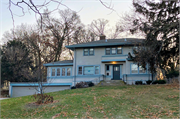Property Record
1126 WABAN HILL
Architecture and History Inventory
| Historic Name: | Charles E. & Bertha Brown Residence |
|---|---|
| Other Name: | |
| Contributing: | Yes |
| Reference Number: | 36516 |
| Location (Address): | 1126 WABAN HILL |
|---|---|
| County: | Dane |
| City: | Madison |
| Township/Village: | |
| Unincorporated Community: | |
| Town: | |
| Range: | |
| Direction: | |
| Section: | |
| Quarter Section: | |
| Quarter/Quarter Section: |
| Year Built: | 1915 |
|---|---|
| Additions: | |
| Survey Date: | 19912019 |
| Historic Use: | house |
| Architectural Style: | Prairie School |
| Structural System: | |
| Wall Material: | Stucco |
| Architect: | |
| Other Buildings On Site: | |
| Demolished?: | No |
| Demolished Date: |
| National/State Register Listing Name: | Nakoma Historic District |
|---|---|
| National Register Listing Date: | 2/26/1998 |
| State Register Listing Date: | 10/17/1997 |
| National Register Multiple Property Name: |
| Additional Information: | Map code is 070932114055. Interesting banding beneath the first story windows. City of Madison, Wisconsin Underrepresented Communities Historic Resource Survey Report: Charles Brown was born in Milwaukee in 1872. In 1900, he became an assistant at the Milwaukee Public Museum, where he reorganized the Wisconsin Natural History Society. In 1903, he helped found the Wisconsin Archeological Society, and in 1904, he was the curator of the United States Philippine Exposition at the St. Louis World Fair. Charles E. Brown was appointed the Director of the State Historical Society of Wisconsin Museum in 1908, serving as its first full-time curator, and moved to Madison. In 1915, Brown was also named to the faculty of the University of Wisconsin-Madison. Charles E. Brown, an American of Anglo-German heritage, devoted much of his professional life to the study and preservation of Indian culture and artifacts as an archaeologist. He published numerous pamphlets and booklets on a wide range of related subjects and organized surveys of native resources across Wisconsin. Brown was instrumental in identifying, studying, and cataloging the mounds around the lakes of Mendota, Monona, Wingra, Waubesa, and Kegonsa and the associated Native American culture associated with them. He estimated that there were at least 887 earthen mounds in the region. He led an effort, from 1908 to 1946, to preserve the mounds, which are sacred to the Ho-Chunk and other native peoples. About 65 percent of the mounds in Dane County, he estimated, have been destroyed during the last two centuries. From 1935 to 1938, Brown also served as director of the Wisconsin Federal Writers Project. During his life, he was the recipient of many academic awards in his field including the Louisiana Purchase Exposition Medal in 1904, the Lapham Medal for anthropological research in 1926, an honorary master’s degree from the University of Wisconsin in 1931, and a medal from the Illinois Academy of Science for archaeological research in 1941. He held the position of director of the State Historical Society until 1945. When he took on the position, the museum had about 25,000 specimens and artifacts in its collection; when he retired the count was over 200,000 items. Charles Brown died in 1946. Brown was significant at the state level in the First Nations community in the area of Education, specifically Museums, from 1908 to 1945. During this time, there were a couple of resources associated with him: The State Historical Society of Wisconsin at 816 State Street and his 1915 to 1945 Prairie style residence at 1126 Waban Hill. The primary resource associated with the life of Charles E. Brown and his significance in Education is the State Historical Society of Wisconsin at 816 State Street, this resource is potentially eligible for designation as a City of Madison Landmark. The building was individually listed in the State and National Registers of Historic Places in 1972 and is listed as a contributing resource in the Bascom Hill Historic District. |
|---|---|
| Bibliographic References: | Architecture/History Survey. April and May, 2001. Prepared by Elizabeth L. Miller. |
| Wisconsin Architecture and History Inventory, State Historic Preservation Office, Wisconsin Historical Society, Madison, Wisconsin |

